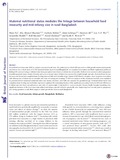Maternal nutritional status mediates the linkage between household food insecurity and mid-infancy size in rural Bangladesh
Date
2020-02-27Publisher
Cambridge University PressAuthor
Na, MuziShamim, Abu Ahmed
Mehra, Sucheta
Labrique, Alain
Ali, Hasmot
Wu, Lee S.-F.
Shaikh, Saijuddin
Klemm, Rolf
Christian, Parul
West, Keith P.
Metadata
Show full item recordCitation
Na, M., Shamim, A. A., Mehra, S., Labrique, A., Ali, H., Wu, L. S. -., . . . West, K. P. (2020). Maternal nutritional status mediates the linkage between household food insecurity and mid-infancy size in rural Bangladesh. British Journal of Nutrition, 123(12), 1415-1425. doi:10.1017/S0007114520000707Abstract
Household food insecurity (HFI) is a major concern in South Asia. The pathways by which HFI may reduce child growth remain inadequately
understood. In a cohort study of 12 693 maternal–infant dyads in rural Bangladesh, we examined association and likely explanatory pathways
linking HFI, assessed using a validated nine-item perception-based index, to infant size at 6 months. Mothers were assessed early in pregnancy
for anthropometric status, dietary diversity and socio-economic status. Infants were assessed for weight, length, and arm, chest and head circumferences and breast and complementary feeding status at birth and 6 months of age. Extent of HFI shared a negative, dose–response association
with all measures of infant size at 6 months and odds of wasting and stunting; 57–89 % of variances in the unadjusted models were explained
by prenatal factors (maternal nutritional status and dietary diversity), and birth size adjusted for gestational age. Postnatal infant breast and
complementary feeding and morbidity exposures explained the remaining fraction of the significant association between HFI and differences
in infant arm and chest circumferences and odds of underweight. Contextual (i.e. socio-economic) factors finally brought remaining nonsignificant fractions of the food insecurity-related mid-infancy growth deficit to practically zero. Improving food security prior to pregnancy
and during gestation would likely improve infant growth the most in rural Bangladesh.

